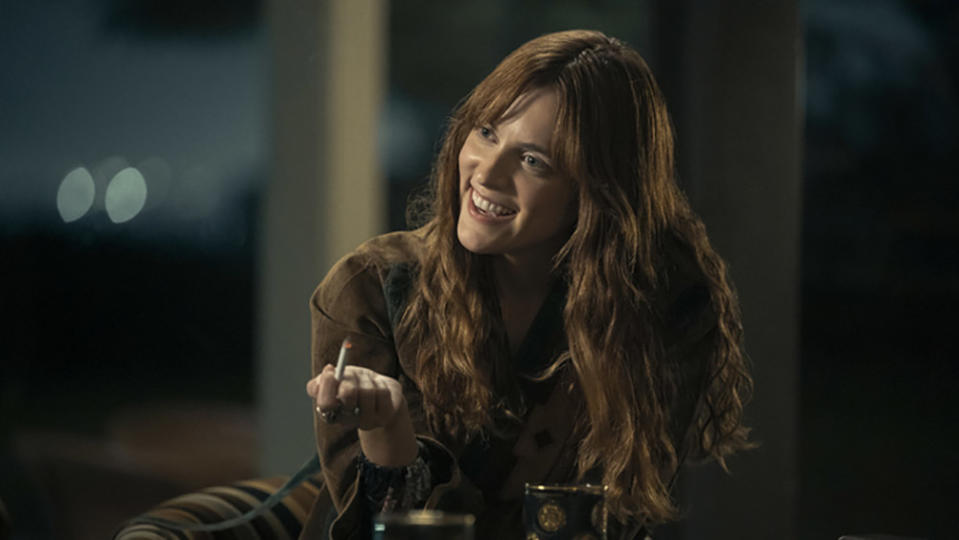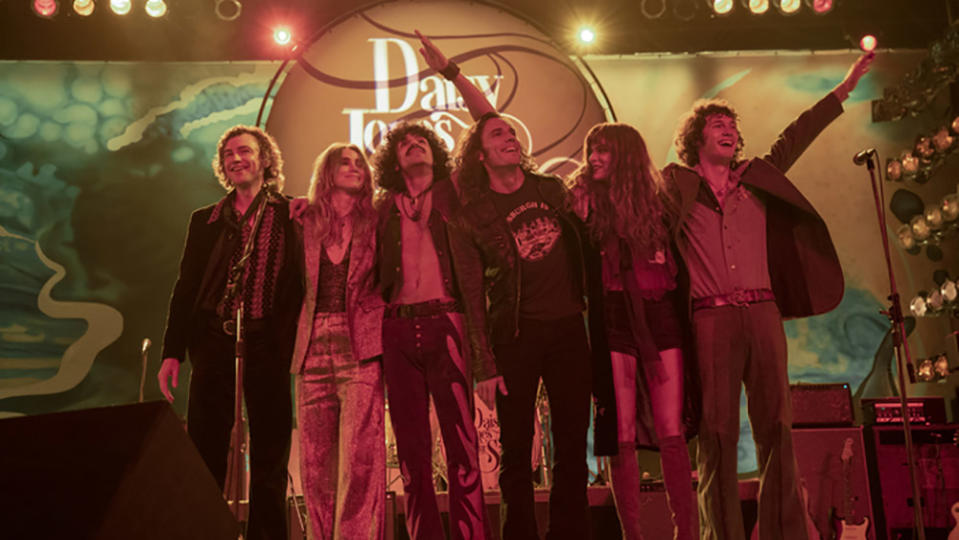Becoming ‘Daisy Jones & the Six’: How Riley Keough and Sam Claflin Transformed From Actors With No Musical Experience to Bona Fide ’70s Rockers
- Oops!Something went wrong.Please try again later.
- Oops!Something went wrong.Please try again later.

From the moment Riley Keough heard about “Daisy Jones & the Six,” she felt it was her destiny to play the title character.
“I just knew I was gonna be Daisy,” she tells Variety about Prime Video’s adaptation of Taylor Jenkins Reid’s bestselling novel, which chronicles the rise and fall of a 1970s rock band. “It was very weird.”
More from Variety
And then the anxiety set in. Despite having music in her blood — she’s the granddaughter of Elvis Presley and daughter of the late Lisa Marie Presley — Keough says she had no professional singing experience coming into the show. That seems almost unbelievable upon hearing the first note she sings, her voice velvety yet jagged, in the debut episode.
“I was really like, I don’t know if I can do it,” Keough says of playing Daisy, a Stevie Nicks-inspired singer-songwriter who falls in lust with her bandmate Billy Dunne (Sam Claflin). “I think there were discussions early on of like, ‘Can they sing it? What do we do if they can’t?'”
Not to worry: “Daisy Jones,” which is backed by Reese Witherspoon’s Hello Sunshine, recruited a stellar music team to bring the band to life. All-star producer and multi-instrumentalist Blake Mills co-wrote and executive produced the 25 original songs heard on the 10-episode series, including the band’s 11-track debut album, “Aurora,” which released on Thursday. Music industry veteran Tony Berg provided additional production and served as chief music consultant, and “Nashville” alum Frankie Pine was the music supervisor.
Berg admits he had his doubts that two non-musicians could pull off what the show’s original music — full of complicated vocal riffs and intricate guitar chords — demanded.
“Our initial concern when Sam and Riley were cast was that it would be putting a lot of pressure on two people who had never sung professionally to be responsible for singing 25 songs. I mean, that’s daunting, isn’t it?” Berg says. “The first sounds they ever made for me and Blake, we looked at each other as if to say ‘uh-oh,’ because it just wasn’t something they had done.”
Claflin says there were even early discussions of having vocal doubles sing on the tracks.
“I remember having that conversation. Like, ‘We’ll get someone else and maybe have a stunt vocalist,’ is what they said,” Claflin says. “I was like, what does that mean? That was the kick in the ass I needed.”
“I was like, fuck that!” Keough agrees.

Enter Pine, who, along with a smattering of musical coaches, led an intensive three-month band camp during which the actors (Keough and Claflin were joined by bandmates Suki Waterhouse, Will Harrison, Josh Whitehouse and Sebastian Chacon) learned to sing and play the original music. Their training was interrupted by the COVID-19 shutdowns in spring 2020, which forced rehearsals to move to Zoom. In a fortuitous twist, the delay in production gave them a year and a half to hone their craft before shooting started in September 2021.
“In all honesty, one of the best things to ever happen to this production was the fact that we had a delay,” Claflin says. That meant that we could all get up to speed and get to the same page.”
Musical skills were key, but just as important: The actors had to perform and interact like a real band would.
“[Bands] spend so much time together that they know what each person’s going to do,” Pine says. “We wanted that experience for our actors so that doing those performances was kind of second hat to them, and then all they would need to worry about was the acting part.”
Though Pine says the band’s performance style wasn’t modeled off of any group in particular, she showed the cast members videos of iconic ’70s acts like Fleetwood Mac and Grace Jones to get them in the groove. Claflin took cues from Bruce Springsteen and Lindsey Buckingham for his on-stage swagger, while Keough’s inspiration was much more abstract.
“I watched tons of videos of live performances and just tried to really understand what the movement would have been and what that world would have been like,” she says. “But I also really felt like Daisy was her own person, and I didn’t want to model her after one person. I think she was a combination of many women and men, actually.”
For Keough and Claflin, a big part of band camp was working one-on-one to establish their vocal chemistry, as nearly every song is a duet. Somewhat surprisingly, the two didn’t sing together during the audition process.
“We met once, and then we walked into this room and had to sing ‘Aurora’ together, which is a pretty hard song to sing,” Keough recalls. “They wanted us to work on our singing chemistry very early on, from day one. So we just kind of met and then were put face-to-face and they were like, ‘Sing at each other!'”
“Be in love!” Claflin adds. “In that moment, the pressure also got lifted a bit. It was like, ‘OK, it’s not just all on my shoulders. It’s not me miles behind everyone else.’ Like, we’ve got this together.”
For Berg, it was imperative that Daisy and Billy didn’t sound too deriviative.
“What we wanted to do was find their real voices, and let them sing as they would if they were the singers in the biggest rock band in the world,” he says. “And to Riley and Sam’s credit, they stepped up.”

Spearheaded by Mills and Berg, the show’s original music combines classic rock sensibilities with an effortlessly modern feel. This was an important balance to strike for creator, co-showrunner and executive producer Scott Neustadter, who was drawn to the duo because they shared his vision that the soundtrack shouldn’t feel like a “fake Fleetwood Mac album.”
“It wasn’t something that had to sound like a lost record of that moment,” he says. “It’s its own thing that you could believe they played on the radio at the time, but that didn’t sound like a parody or some kind of fake version of that.”
To give the music even more originality, the team made the decision not to use the lyrics already written in Jenkins Reid’s novel, opting instead to pen the songs entirely from scratch.
“I think what everyone felt was, let’s get the essence of what that era was without being too imitative or too constrained, so that it would meet Blake’s criteria for songwriting while doing what the show needed,” Berg says.
Mills and Berg, who run the historic Sound City Studios in Los Angeles where legends like Elton John and Neil Young recorded, involved the studio’s vibrant community in the project, resulting in writing credits from such notable artists as Marcus Mumford, Phoebe Bridgers and Jackson Browne.
Mumford, who co-wrote “Look at Us Now (Honeycomb)” — the Six’s first major hit which is showcased in Episode 3 — was recruited while working on his solo record, “Self-Titled,” with Mills.
Mumford first heard about “Daisy Jones & the Six” from Mills nearly four years ago, and was happy to support his friend on this “epic quest” that he knew had been quite challenging. Working on the track, a heated back-and-forth between Daisy and Billy disguised as a feel-good anthem, was a welcome distraction for the Mumford & Sons frontman, who believes “writing begets more writing.”
“Writing this slightly embattled dialogue between these two characters was just a really fun exercise,” Mumford says. “And then it was just about making the song as cool as we could, and the melody feel like it’s one that could survive for a long time and could launch a band… I remember it feeling extremely collaborative, open-hearted and with the free spirit that I think ends up being conveyed in the song.”
To get inspired, Mumford says he and his fellow co-writers — Mills, Jason Boesel, Stephony Smith and Jonathan Rice — listened to Paul McCartney and Lindsey Buckingham’s early solo records, as well as Joni Mitchell’s 1976 album “Hejira.”
“That stuff is in the walls, you know?” he says of Sound City, where the show also filmed scenes of the band recording. “You can feel the Jackson Browne, Neil Young, Fleetwood Mac essence in those walls because so many of those records were made there.”
Upon hearing Keough and Claflin sing “Look at Us Now” for the first time, Mumford was wildly impressed.
“It’s funny, the first time I listened to [the song] I was like, ‘Oh that’s weird, they used Blake’s voice.’ But it’s not. It’s just that Sam studied Blake’s vibrato so perfectly that it sounds like Blake’s vibrato,” Mumford says. “I was amazed by that. And I think Riley just gets all the kind of vituperative spirit of that lyric so well. It’s pretty radical what they were able to do, I’ve got enormous admiration for them.”
He pauses, then adds with a laugh: “It kinda pisses me off a little bit actually.”
Toward the end of their training, Pine had the band perform live for a room full of execs and the show’s crew as a final test of sorts. But she says her dream is to see the group play at one of L.A.’s iconic venues featured in the series, like The Troubadour.
“I feel like that’s how good we made them, you know, that they could get up there and play it live,” she says. “I really just want everyone to believe that this is a real band.”
So, is there ever hope for a real Daisy Jones & the Six tour? Keough and Claflin aren’t ruling it out.
“I think that we’d all love to, if it was the right moment,” Keough says. “We want a comeback show!”
“And we can,” Claflin adds. “That’s the beautiful thing.”
“Daisy Jones and the Six” is now available to stream on Prime Video.
Best of Variety
From 'Daisy Jones & The Six' to 'Blonde': Books Made Into Movies and TV Series That You Should Read
Oscar Predictions: Documentary Short - Could ‘Stranger at the Gate’ Surprise on Oscar Night?
Sign up for Variety’s Newsletter. For the latest news, follow us on Facebook, Twitter, and Instagram.

